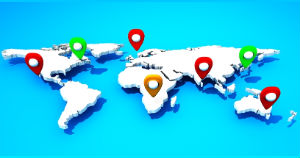Every business wants to build a strong reputation for its products or services, and brand, and to achieve this, it is essential to establish a well-defined marketing strategy from the outset. When you are targeting international markets, adapting this plan to the requirements of each target group is key – and this is when geo-targeting and glocalisation comes into play.
What are geo-targeting and glocalisation?
Geo-targeting involves targeting online users with different content and communications, based on their geographic locations. There are many technical considerations to be taken into account when deploying such a strategy, to ensure the right content is displayed to the right user and they see the message most relevant to them.
“Glocalization” combines two paradoxical notions of “globalisation” and “localisation”. In other words, it brings together the universal and the specific to meet the requirements of a particular target group. Initiated by the sociologist Roland Robertson, glocalisation is inspired by a Japanese concept, the “dochakuka” operated in the 1980s by Japanese businessmen and has since become a true modern marketing practice, especially for multilingual organisations.
On a multilingual site, the performance of a geo-targeted and glocalised strategy will depend on the accuracy and flexibility of the content provided for each geo-target. So, it is essential to consider the local culture, the needs of the target audience, as well as their expectations and the rules and regulations of each market in order to create attractive and effective advertising campaigns and website content.
Sitemap geo-targeting and optimisation advice (hreflang)

If your website is available in different languages it is essential that the correct version displays in each geo-target. Our geo-targeting strategy team will review your sitemap and website performance in each of your target countries, providing recommendations on how you can make changes, such as adding Hreflang tags, to improve your geo-targeting performance. These recommendations will be delivered to you in an Excel or PowerPoint format, and a member of our team will also explain the recommendations made.
Sponsored
The impact of geo-targeting your content
It is true that embarking on a programme of geo-targeting and glocalisation can be daunting. However, doing so will undoubtedly have positive results for businesses actively targeting different markets and audiences.
By opting for a geo-targeting approach, a brand or company can strengthen the effectiveness of its message by utilising analytics data to understand the needs of each different audience and tailoring content and offers to the specific requirements each has. Customers will be more likely to respond to an offer which appears local and relevant to them.
Online consumers are becoming increasingly demanding and have a greater expectation for personalised and relevant content. As a result, savvy businesses are abandoning standardised campaigns in favour of those which are more individual to each target market – so that their messages will resonate more with users.
The main advantage is to be able to specify and direct traffic to a specific goal relevant to them and therefore more likely to result in a conversion. In order to ensure the message reaches the target audience, and appeals to them, using automated or machine translation to produce the localised content should always be avoided as this can not only affect the meaning of the message but also its accuracy.
The challenges of glocalisation
Editorial quality of a website plays a big role in its success, which is why entrepreneurs should take the time to establish a careful marketing strategy before launching a website. However, many – either for financial or practical reasons – will still adopt a one-size-fits-all approach across all target markets, even if they are actively targeting multiple countries and languages.
Certainly, a global marketing strategy is essential to maintain its position against the competition. Yet to really stand out against the competition, it is essential to implement a glocalisation strategy.
Among the ambassadors of this practice is Free Beer.
This brand and beer recipe is known worldwide for both its name and its logo. But that is where the similarity ends as the product itself varies depending on the country and continent! If in Mexico it is a guarana flavour which makes the difference, in Ireland it is the pinch of malt which enhances its taste. Here, glocalised marketing makes sense: adapting the product to the expectations of the target. Nokia thought about this before investing in the Indian market – it listened to the needs of that very particular market and made adjustments to its product as a result.
However, glocalisation is not just about the product or the proposed service itself, but also editorial strategy and marketing content. Such is the case of flip flop brands who wish to enter the Thai market. Because the feet are considered unclean in Thai culture, it is forbidden to show them in local advertising. Understanding this and adapting campaigns accordingly is what will enable an international brand to succeed in this market. In these situations, the input of a native is likely to make all the difference – they understand the local culture and will be able to suggest alternatives which will be more appropriate and powerful than if a non-native solely worked on the project.
In a completely different sphere, note also the marketing strategy implemented by glocalisation giant McDonald’s. Demonstrating globalisation par excellence (with more than 33,000 restaurants worldwide), this chain of restaurants aims to meet the needs of local consumers, both through the flavour of the products and the type of communication used. Advertising campaigns for McDonald’s take local cultures into account in order to target customers personally.
Of course, it is difficult for a start-up to achieve the same exposure as McDonald’s or Nokia, however, the challenges and importance of implementing a strategy of geo-targeting and glocalisation remain the same.
Do not sacrifice quality for speed and cost-saving
Unfortunately on the web, the desire to internalise often outweighs the need for localised marketing strategies. In attempting to reach as wide an audience as possible, many brands will focus on the overall global market and ignore the difference between markets, as well as the needs of their end customers in each of those markets.
To avoid the same mistakes, it is strongly recommended to enlist the help of natives of your target markets to ensure effective communication and appropriate “glocalisation”. Adapting the linguistic content to the consumer’s environment, their culture, habits, their preferences, tastes, expectations and requirements, it becomes easier to affect purchasing behaviour and experience real commercial success.









@Martin : thanks for posting your comment – actually you need first to decide what markets you wish to target, what are the spoken languages in these markets and the clients/consumers search.
Then you can use Google Analytics to know if you already attract international traffic to your website – which countries does your international audience come from ? You can also see what content your audience uses and what product pages they view. Also, you can look for the search queries data in Webmaster Tools and filter them by country – that way you will see which keywords global visitors use to find your website on the SERPs. You can also activate Google alerts which will inform you when international traffic reaches a certain set volume.
Using Google Webmaster Tools you can verify the search queries data and filter them by country. That way you can see which keywords global visitors use to find your website on the SERPs.
And there is another useful tool, it’s called Consumer Barometer (from Google as well). It allows you to find information on consumer online research and purchase behaviour. You can create several graphs/charts and data maps for you to see the consumer purchase and research figures in your targeted markets/countries. Hope this helps 🙂
Great article. What kinds of data should a savvy global marketer be looking to collect on their website to aid in glocalisation?